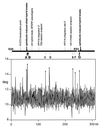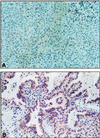Cancer-specific chromosome alterations in the constitutive fragile region FRA3B
- PMID: 10377436
- PMCID: PMC22107
- DOI: 10.1073/pnas.96.13.7456
Cancer-specific chromosome alterations in the constitutive fragile region FRA3B
Erratum in
- Proc Natl Acad Sci U S A 1999 Sep 14;96(19):10944
Abstract
We have sequenced 870 kilobases of the FHIT/FRA3B locus, from FHIT intron 3 to intron 7. The locus is AT rich (61.5%) and Alu poor (6. 2%), and it apparently does not harbor other genes. In a detailed analysis of the 308-kilobase region between FHIT exon 5 and the telomeric end of intron 3, a region known to encompass a human papillomavirus-16 integration site and two clusters of aphidicolin-induced chromosome 3p14.2 breakpoints, we have precisely mapped 10 deletion and translocation endpoints in cancer-derived cell lines relative to positions of specific repetitive elements, regions of high genome flexibility and aphidicolin-induced breakpoints. Conclusions are (i) that aphidicolin-induced breakpoint clusters fall close to high-flexibility sequences, suggesting that these sequences contribute directly to aphidicolin-induced fragility; (ii) that 9 of the 10 FHIT allelic deletions in cancer cell lines resulted in loss of exons, with 7 deletion endpoints near long interspersed nuclear elements or long terminal repeat elements; and (iii) that cancer-specific deletions encompass multiple high-flexibility genomic regions, suggesting that fragile breaks may occur at these regions, whereas repair of the breaks involves homologous pairing of flanking sequences with concomitant deletion of the damaged fragile sequence.
Figures





References
Publication types
MeSH terms
Substances
Associated data
- Actions
- Actions
- Actions
Grants and funding
LinkOut - more resources
Full Text Sources
Other Literature Sources

